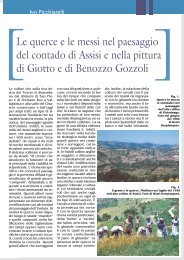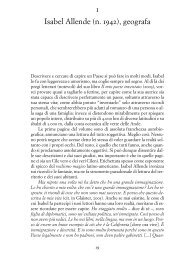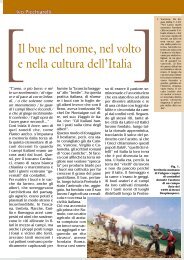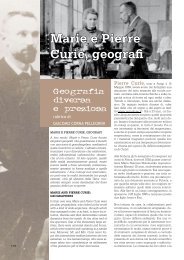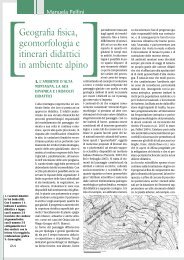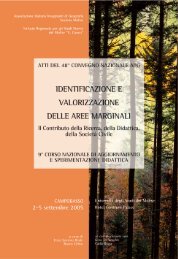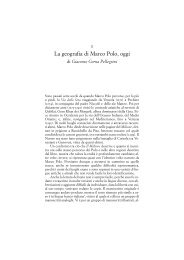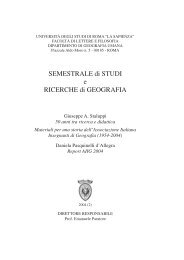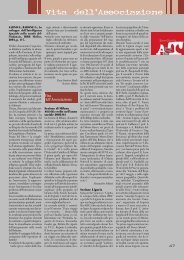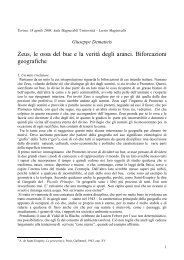Terre di mezzo: la Basilicata tra costruzione regionale e proiezioni ...
Terre di mezzo: la Basilicata tra costruzione regionale e proiezioni ...
Terre di mezzo: la Basilicata tra costruzione regionale e proiezioni ...
You also want an ePaper? Increase the reach of your titles
YUMPU automatically turns print PDFs into web optimized ePapers that Google loves.
Laura Stanganini<br />
Arezzo, mira a favorire <strong>la</strong> riorganizzazione produttiva e commerciale del settore<br />
caffeario nell’area <strong>di</strong> Jamao Salcedo nel<strong>la</strong> Repubblica Dominicana. Nonostante<br />
il caffè sia il prodotto principale dell’economia locale, molti conta<strong>di</strong>ni<br />
abbandonano le loro coltivazioni a causa del crollo dei prezzi nelle borse<br />
internazionali. Alle ripercussioni sociali dell’emigrazione si accompagna il<br />
degrado ambientale caratterizzato dal<strong>la</strong> deforestazione e dall’erosione delle terre,<br />
con gravi ripercussioni sul<strong>la</strong> bio<strong>di</strong>versità. L’obiettivo del<strong>la</strong> campagna è quello <strong>di</strong><br />
realizzare un prodotto <strong>di</strong> qualità che possa accedere a canali <strong>di</strong> ven<strong>di</strong>ta<br />
alternativi rispetto a quelli delle multinazionali, che non consentono <strong>di</strong><br />
recuperare neppure i costi <strong>di</strong> produzione, e permettere così ai coltivatori <strong>di</strong><br />
reinvestire nel<strong>la</strong> loro attività commerciale e continuare a vivere nel<strong>la</strong> propria<br />
terra; all’ambiente dell’area <strong>di</strong> Jamao <strong>di</strong> preservare <strong>la</strong> sua bio<strong>di</strong>versità; al<br />
consumatore <strong>di</strong> acquistare un prodotto <strong>di</strong> qualità in un rapporto equo e solidale<br />
verso chi lo produce.<br />
Dal<strong>la</strong> rivitalizzazione del settore caffeario è nata infine l’idea <strong>di</strong> un progetto<br />
per il turismo responsabile. “La ruta del caffè” è un’iniziativa che <strong>tra</strong>e ispirazione<br />
dall’esperienza toscana “Le s<strong>tra</strong>de del vino” e si basa sul<strong>la</strong> valorizzazione<br />
ambientale, culturale e turistica <strong>di</strong> Salcedo, partendo da quel<strong>la</strong> <strong>di</strong> un suo<br />
prodotto tipico, il caffè. In percorso turistico al<strong>la</strong> scoperta dei luoghi e delle<br />
<strong>tra</strong><strong>di</strong>zioni ripercorre infatti l’intera filiera del caffè e coinvolge <strong>di</strong>rettamente <strong>la</strong><br />
popo<strong>la</strong>zione locale (albergatori, artigiani, produttori).<br />
Un modulo Clil<br />
Quanto esposto finora (<strong>la</strong> realtà dell’associazionismo, delle “Botteghe del<br />
Mondo” nonché le <strong>di</strong>verse iniziative regionali) riassume il contesto <strong>di</strong>sciplinare e<br />
territoriale <strong>di</strong> riferimento per il modulo Clil. L’autrice, insegnante <strong>di</strong> lingua<br />
inglese, decide in col<strong>la</strong>borazione con l’insegnante <strong>di</strong> italiano, storia e geografia <strong>di</strong><br />
organizzare una visita guidata al<strong>la</strong> sede dell’Ucodep e al<strong>la</strong> “Bottega del Mondo”<br />
aretina. Durante <strong>la</strong> visita, che avviene dopo alcune lezioni <strong>di</strong> preparazione sul<br />
tema, si svolge un <strong>la</strong>voro <strong>di</strong> gruppo in lingua inglese. La scheda <strong>di</strong>dattica<br />
utilizzata per tale <strong>la</strong>voro raccoglie attività <strong>di</strong> brainstorming, matching, role-p<strong>la</strong>y,<br />
yes/no questions, group and pair work, e nasce dal<strong>la</strong> rie<strong>la</strong>borazione <strong>di</strong> materiale<br />
<strong>di</strong>dattico e <strong>di</strong>vulgativo scaricabile dal sito dell’associazione Fair<strong>tra</strong>de, una delle<br />
più importanti.<br />
(1 st part) QUESTIONNAIRE<br />
Scheda <strong>di</strong>dattica<br />
What is Fair<strong>tra</strong>de? FAIR means ............. and TRADE means ...............<br />
Farmers in the South who grow our coffee, tea, cocoa, bananas and more are often very poor. They<br />
struggle to survive in a system of world <strong>tra</strong>de that is not fair. Fair<strong>tra</strong>de means paying farmers in the<br />
South a fair price for their work. A price that covers the cost of production – no matter how low the<br />
market price goes. Fair<strong>tra</strong>de is not charity – if producers are paid a fair price for their products, they<br />
don’t need charity.<br />
How do I know if something is Fair<strong>tra</strong>de?<br />
The FAIRTRADE Mark is a <strong>la</strong>bel that appears in more than 850 products. The new FAIRTRADE Mark is<br />
a symbol of a person with their hand held high - it helps us to spot Fair<strong>tra</strong>de goods when we are shopping.<br />
178



